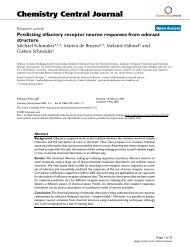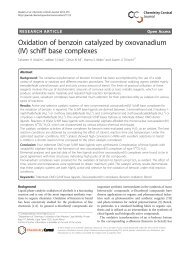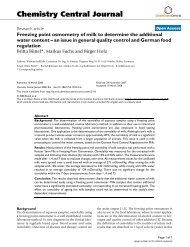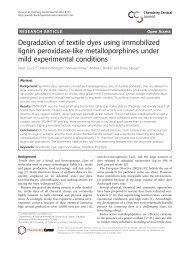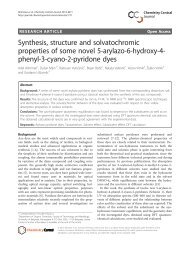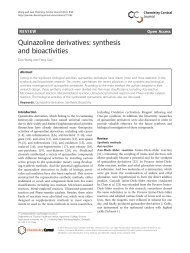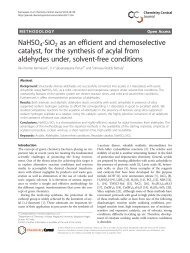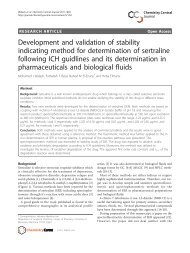Stress degradation studies and development of stability-indicating ...
Stress degradation studies and development of stability-indicating ...
Stress degradation studies and development of stability-indicating ...
You also want an ePaper? Increase the reach of your titles
YUMPU automatically turns print PDFs into web optimized ePapers that Google loves.
Musharraf et al. Chemistry Central Journal 2012, 6:7<br />
http://journal.chemistrycentral.com/content/6/1/7<br />
μL (6000 ng/spot) <strong>of</strong> each treated solution was applied<br />
on TLC plate in triplicate for chromatographic analysis.<br />
Results <strong>and</strong> discussion<br />
Optimization <strong>of</strong> TLC system <strong>and</strong> method validation<br />
With the aim to develop a reliable <strong>stability</strong> <strong>indicating</strong><br />
method, solvent system was optimized with st<strong>and</strong>ards,<br />
samples <strong>and</strong> degraded products. Different solvent systems<br />
<strong>of</strong> 2-propanol, toluene, ether, chlor<strong>of</strong>orm, methanol,<br />
glacial acetic acid <strong>and</strong> acetone were tried in varying<br />
ratios. Solvent systems <strong>and</strong> resulting R f values <strong>of</strong> both<br />
st<strong>and</strong>ards are summarized in Table S1 [see Additional<br />
file 1]. Most <strong>of</strong> the solvent systems showed diffused<br />
spots <strong>of</strong> prednisolone acetate. Suitable separation with<br />
best resolution was achieved with chlor<strong>of</strong>orm: methanol<br />
(14: 1 v/v) which showed sharp b<strong>and</strong>s with R f value <strong>of</strong><br />
chloramphenicol at 0.21 ± 0.02 <strong>and</strong> <strong>of</strong> prednisolone<br />
acetate at 0.41 ± 0.03 (Figure 2).<br />
Figure 2 Chromatogram <strong>of</strong> (a) st<strong>and</strong>ard chloramphenicol at<br />
lmax 278 nm (b) st<strong>and</strong>ard prednisolone acetate at lmax 243<br />
nm (c) st<strong>and</strong>ard prednisolone acetate <strong>and</strong> chloramphenicol in<br />
combination at l 278 nm.<br />
St<strong>and</strong>ard calibration curve for both prednisolone acetate<br />
<strong>and</strong> chloramphenicol in the concentration range <strong>of</strong> 200-<br />
6000 ng was found linear with r 2 ± S.D. 0.9966 ± 3.5<br />
<strong>and</strong> 0.9920 ± 2.5, respectively. For Intra-day <strong>and</strong> interday<br />
precision, % R.S.D. observed for prednisolone acetate<br />
was 1.32 <strong>and</strong> 3.90, respectively while for chloramphenicol,<br />
1.09 <strong>and</strong> 1.68, respectively. For prednisolone<br />
acetate <strong>and</strong> chloramphenicol, LODs were found to be<br />
4.77 <strong>and</strong> 3.00 ng/μL, respectively while LOQs were<br />
found to be 14.46 <strong>and</strong> 9.12 ng/μL, respectively. For<br />
robustness analysis, the S.D. <strong>of</strong> peak area <strong>of</strong> st<strong>and</strong>ard<br />
levels (200, 400 <strong>and</strong> 800 ng) was estimated for each<br />
parameter. S.D. was 1.07 <strong>and</strong> 3.9 for changing the<br />
amount <strong>of</strong> mobile phase, 2.48 <strong>and</strong> 2.70 for varying in<br />
mobile phase composition, 0.95 <strong>and</strong> 2.96 for varying<br />
time from spotting to chromatography, 0.56 <strong>and</strong> 1.09<br />
for varying time from chromatography to scanning <strong>and</strong><br />
1.53 <strong>and</strong> 1.32 for varying chamber saturation time for<br />
prednisolone acetate <strong>and</strong> chloramphenicol, respectively.<br />
SD for peak areas were calculated <strong>and</strong> summarized in<br />
Table S2 [see Additional file 1]. Spiking <strong>studies</strong> showed<br />
recovery <strong>of</strong> prednisolone acetate (98-104%) <strong>and</strong> chloramphenicol<br />
(93-101%) from their pharmaceutical products<br />
(Table S3 [see Additional file 1]). Peak purity was<br />
estimated by comparing the peak positions <strong>of</strong> both prednisolone<br />
acetate <strong>and</strong> chloramphenicol in st<strong>and</strong>ard<br />
spectra with those in reaction solutions. Good correlation,<br />
r 2 (start, middle) = 0.999 <strong>and</strong> r 2 (middle, end) =<br />
0.9999 was observed by comparing the spectra <strong>of</strong> st<strong>and</strong>ard<br />
<strong>and</strong> samples, in both cases. The linear regression<br />
data <strong>and</strong> the method validation results are summarized<br />
in Table 1.<br />
Stability <strong>indicating</strong> property in prednisolone acetate<br />
76.2% <strong>of</strong> prednisolone acetate was decomposed in 1N HCl<br />
<strong>and</strong> 100% in 5N HCl. Three additional peaks at R f 0.01,<br />
Table 1 Linear regression data <strong>and</strong> validation parameters<br />
<strong>of</strong> prednisolone acetate (1) <strong>and</strong> chloramphenicol (2).<br />
Parameters Prednisolone<br />
acetate<br />
(at lmax 243 nm)<br />
Page 4 <strong>of</strong> 9<br />
Chloramphenicol<br />
(at lmax 278 nm)<br />
Linearity range 200-6000 ng/spot 200-6000 ng/spot<br />
Correlation coefficient, r 2 ±<br />
SD<br />
0.9966 ± 3.5 0.9920 ± 2.5<br />
Slope ± SD 2.42 ± 0.5 2.74 ± 0.34<br />
Intercept ± SD 1106 ± 0.48 4183 ± 2.15<br />
Y = mx + c 2.42x + 1106 2.738x + 4183<br />
Intra-day (n = 3), % RSD 1.32 1.09<br />
Inter-day (n = 3), % RSD 3.90 1.68<br />
Limit <strong>of</strong> detection 4.77 ng/μL 3.0 ng/μL<br />
Limit <strong>of</strong> quantification 14.46 ng/μL 9.12 ng/μL<br />
Robustness Robust Robust<br />
Specificity Specific Specific





